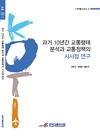Basic Report

RESEARCH
KOTI - Korea Transport institute
A Decade of Change in Korean Travel Patterns and Policy Implications
- Date
October 31 2012
- Page(s)
page(s)

During the past decade, we have experienced socioeconomic and demographic changes such as the five day working week, patterns of a decreased number of students making home to school trips, and a trend towards the nuclear family and aging society.
First of all, the five day working week has reduced commuting trips and increased weekend trips. In addition, the amount of home to school trips has shrunk by the new five-day a week education system and a day off every other Saturday. The spread of five working days and five school days a week has changed the social trends of the consuming time pattern from personal to family levels, and it affects our entire society’s time spending pattern, which is expected to become undergo a larger scale change. There are gradual innovations in personal tastes and activities, as well as families and the relationship between family members. Tastes and activities of both individuals and the family have changed gradually. Relationships among family members and friends also has altered significantly compared with the past, and are expected to influence the perception of travel mode because of the increased variation of tastes in individuals.
This research’s main purpose is to examine the vision of transportation policies under the issues associated with the country’s socioeconomic and demographic aspects. The research will delve into these throuhg studying characteristics of citizens' trip patterns over a decade. To conduct the research, we gathered census data including trip profiles of household travel, as well as transport related data for the past ten years. These datasets are analyzed in terms of the trip pattern alteration of Koreans through social factors. This, in turn, allows the finding of important facts.
Under the purpose of identifying how commuting patterns have changed, we try to find the changed factors. These findings will reveal the implications of transportation policies and draw practical ways to maximize social benefits. This research could largely be separated by three main categories. First, by investigating the correlation between locations, transportation modes, characteristics of individuals, family structure and trip behavior, this research finds the main issues and findings. Secondly, corroborative evidence analysis in this research delves into the datasets from a survey of the national population and housing from a household travel survey taken between 2000 and 2010. Finally, we discuss policy implications.
Some empirical findings are as follows. There were significant changes of vehicle ownership, its usage and commuting patterns.
There were significant shifts in the trip pattern of public transportation as well as the use of non-motorized transportation modes. Next, there were significant changes in school trip patterns and inter-city trip patterns. Finally, there were changes in weekend trip patterns and travel patterns of older people.
Based on the important findings above, we found new ideas for transportation policies. In this research, we suggest the basic topic in terms of mid to long term transportation policies through experience of the past ten years and propose practical policy choices. The main point is that transportation policies should consider the complicated changes which could be intertwined with transportation problems derived from various factors such as an aging society, single households, increased life longevity, the working hour system, and the change in education policies